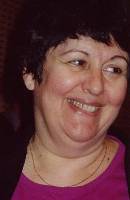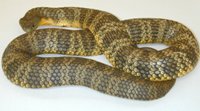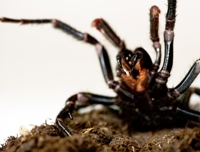


Venomous Country
Participants
Venomous Country
Endnotes
Index
Search
Help
Contact us

Janet McCalman[1]: This inaugural Australian Witness seminar provides an opportunity to hear the recollections and reflections of people at the coalface of innovations in toxicology in Australia. It provides a way to celebrate the life and contribution to venom research of the late Dr Struan Sutherland, a major contributor to the field.[2] Dr Ken Winkel, who worked closely with Struan Sutherland since 1996, will lead the discussion.

Photograph courtesy of Ann Westmore
Ken Winkel[3]: Today we will necessarily take up only part of the story of venom research in Australia since the 1960s. The vignettes will not be complete because some of the key contributors unfortunately could not be here today - people such as James Tibballs,[4] co-author with Struan Sutherland of the second edition of Australian Animal Toxins,[5] and Malcolm Fisher, the man who used the first batch of funnel web spider antivenom to save a patient's life and who thereby demonstrated its efficacy.[6] But some of you have personal recollections of Struan, and memories of particular interactions with him and his team. Feel free to share them. It's all about sharing oral history here today.
Struan's involvement with the Commonwealth Serum Laboratories (CSL)[7] began with his arrival as medical officer on the 18th of April, 1966. Within a year he was given the headship of the Immunology Research Unit or Department at CSL.[8] Very shortly after that or just around that time, he started work on the blue-ringed octopus and reactivated the funnel- web spider antivenom project.[9] All of these things happened in '67. He was also working on various CSL vaccine projects.
In 1970 he started a major project on snake venom, characterising Australian snake venoms and their toxicity, and trying to isolate the toxins. The same year, he and his team began work on isolating the main toxin from the venom of the tiger snake (Notechis scutatus scutatus).[10] They also established a radioisotope laboratory at CSL. Then in 1972, they detected snake venom in human tissues for the first time using radioimmunoassay.[11]

In the 1970s, further neurotoxins were isolated including the most potent toxin in snake venom then known to man, textilotoxin.[12] Alan Coulter can tell us more about that. In 1974, a major survey of the effects of animal toxins and care of the envenomed patient was undertaken,[13] and a Department of Pharmacological Research established. Then in 1976, a survey of antivenoms' properties and possible causes of adverse reactions to them was commenced, which still hasn't been bettered.[14]
In 1977, Struan and his team started a major study on the movement of venom in animals, particularly snake venoms. An investigation of first aid measures also started. In 1978 the pressure-immobilisation technique was actually developed[15] and a survey of more than two thousand cases of Australian red-back spider bites (Latrodectus hasseltii), the largest series ever, was published.[16] The same year saw a publication on the detection of the venom of the inland taipan (Oxyuranus s. scutellatus).[17] That venom was found to be the most toxic yet described.[18]
The year, 1979, brought together more of Struan's work at CSL. An article on the pressure-immobilisation technique and its value in treating Australian snake bites was published in The Lancet.[19] A survey of the toxicity of the world's major snake venoms was conducted as was a study of the effects on monkeys of all major Australian snake venoms.[20] A twelve-month survey of the use of antivenoms in Australia was also undertaken and snake venom detection kits were issued to Australian hospitals for the first time.[21]
In January 1980, experiments suggested that pressure-immobilisation was a suitable first aid technique for funnel-web spider bites. Then, on 7 February, Struan was suspended from CSL after a dispute with the Director over staff cuts, only to be reinstated on 21 February. [22] The following month was notable for the start of collaboration with Drs Duncan and Tibballs at the Royal Children's Hospital to explore possible treatments for funnel-web spider victims.[23] In April, a renewed attempt was made to develop the funnel-web spider antivenom and on 24 June, there was the first sign that this attempt would prove fruitful. Perhaps John Pearn will enlighten us about the events of that particular day. In July, in monkeys, the experimental funnel-web spider antivenom was shown to be effective and, by December, there was sufficient product for a clinical trial to be launched.

On 1 February 1981 the first clinical use of funnel-web spider antivenom occurred. Malcolm Fisher, who was treating the patient, rang up and said "Struan, you've just ruined a beautiful bloody syndrome!" June 17 was Struan's forty-fifth birthday and the following day the infamous paper clip incident occurred.[24] A series of court hearings took place during the following months before Struan resumed work on 26 August. So with that background, I would invite the panel to start their reminiscences of their first memories of Struan, particularly those at CSL.
 |
Witness to the History of Australian Medicine |  |
© The University of Melbourne 2005-16
Published by eScholarship Research Centre, using the Web Academic Resource Publisher
http://witness.esrc.unimelb.edu.au/074.html